
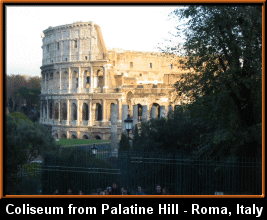 I've always wanted to go to Italy ever since Latin class in High School (most if not all of which
I have forgotten over the years) where we not only learned the language, but also the culture of the
ancient Romans. The Forum, the Coliseum, the Palatine...the birthplace (along with Greece) of
western civilization: I wanted to see it all. Unlike some other foreign adventures, I also had a
secret weapon: A wife who had lived in Florence and who speaks fluent Italian! This was going to
be great.
I've always wanted to go to Italy ever since Latin class in High School (most if not all of which
I have forgotten over the years) where we not only learned the language, but also the culture of the
ancient Romans. The Forum, the Coliseum, the Palatine...the birthplace (along with Greece) of
western civilization: I wanted to see it all. Unlike some other foreign adventures, I also had a
secret weapon: A wife who had lived in Florence and who speaks fluent Italian! This was going to
be great.
Despite my reluctance about getting on a plane only a few days after returning from two weeks in
Hyderabad, India, I was really excited. I really cannot describe
the relief that I felt finally getting off the plane (and staying off) in Europe instead of
continuing to another destination! We took a red-eye from San Francisco with a layover in Atlanta and
arrived in Rome's Fiumicino Airport
under cloudy skies at around 8:00am. Customs and immigration were a breeze and we headed for Fiumicino's
train terminal to catch a train into Rome. The train ride to Rome's Termini Station took about 30
minutes. We had planned to stuff our luggage into some lockers at Termini and see some sites in
Rome until we were able to check into our hotel, but the events of 9/11 had again taken their toll:
The storage lockers had been rendered useless as a security precaution. Fortunately, there was still a
luggage check in operation. After queuing to leave our stuff, we were finally ready to explore Rome.
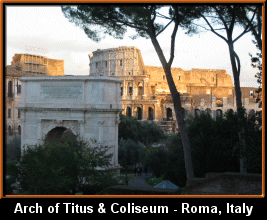 Termini was similar in design to other train stations in Europe that I have visited, despite the rather
strange architectural concept of "art deco meets the 70's". The most amazing thing? Even the restroom floors
were made of Travertine marble. What a lesson in economics: The price of a material is relative to what
material is available in the immediate area. After seeing all the Travertine in the buildings (and even sidewalks)
in Rome, it's no wonder this material is so expensive in the United States! We headed North from the station,
walking towards the Piazza della Repubblica, eventually working our way westward towards the
Vittorio Emanuele monument. Here we dodged the increasing raindrops (OK, i'm being a little sarcastic:
It was pouring at this point) by climbing the steps to the monument that locals call 'The Typewriter'
or 'The Birthday Cake' and walking around it's open, but covered halls. We were able to get away from the rain
completely for a while by visiting the museum of Italian military history inside the monument. From the top of
this imposing monument, you have fantastic views of almost all of the things that you could possibly want to see
in Rome: To the East rises the dome of St. Peter's Cathedral in the Vatican. Immediately below (to the north)in
the Piazza Venezia, you can see the balcony from which Mussolini gave almost daily speeches during WWII
(old Italian joke: "at least he got the trains running on time"). To the West, you can look down on the ruins
of Trajan's column, one of the oldest ruins from the Roman Empire. The view to the South is the most impressive:
at your feet, stretching for almost half a mile are the remains of the Foro Romano, dominated by Palatine
hill on the left and terminating in the far South with the Coliseum.
Termini was similar in design to other train stations in Europe that I have visited, despite the rather
strange architectural concept of "art deco meets the 70's". The most amazing thing? Even the restroom floors
were made of Travertine marble. What a lesson in economics: The price of a material is relative to what
material is available in the immediate area. After seeing all the Travertine in the buildings (and even sidewalks)
in Rome, it's no wonder this material is so expensive in the United States! We headed North from the station,
walking towards the Piazza della Repubblica, eventually working our way westward towards the
Vittorio Emanuele monument. Here we dodged the increasing raindrops (OK, i'm being a little sarcastic:
It was pouring at this point) by climbing the steps to the monument that locals call 'The Typewriter'
or 'The Birthday Cake' and walking around it's open, but covered halls. We were able to get away from the rain
completely for a while by visiting the museum of Italian military history inside the monument. From the top of
this imposing monument, you have fantastic views of almost all of the things that you could possibly want to see
in Rome: To the East rises the dome of St. Peter's Cathedral in the Vatican. Immediately below (to the north)in
the Piazza Venezia, you can see the balcony from which Mussolini gave almost daily speeches during WWII
(old Italian joke: "at least he got the trains running on time"). To the West, you can look down on the ruins
of Trajan's column, one of the oldest ruins from the Roman Empire. The view to the South is the most impressive:
at your feet, stretching for almost half a mile are the remains of the Foro Romano, dominated by Palatine
hill on the left and terminating in the far South with the Coliseum.
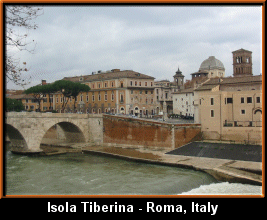 The Vittoriano is a great place to
"get your bearings" in 'Old Rome'. Our friends have told us that Romans really dislike this stark, white and
modern edifice (compared - literally - to what's behind it), which probably explains the lack of
information available on the web about this place!
The Vittoriano is a great place to
"get your bearings" in 'Old Rome'. Our friends have told us that Romans really dislike this stark, white and
modern edifice (compared - literally - to what's behind it), which probably explains the lack of
information available on the web about this place!
To the immediate right of the Vittoriano is the Piazza del Campidoglio, an impressive square
designed by Michelangelo. This square houses two
museums: The Palazzo dei Conservatori, on the right, and Palazzo Nuovo, on the left.
Unfortunately, we did not have time to visit these museums (besides, visiting all of the museums in Italy
would leave a person very broke - we calculated that our museum visits over the course of a mere week in
Florence and Rome would run nearly $300).
Behind the Vittoriano and the Piazza del Campidoglio lies the Roman Forum. Despite the
drizzle and frequent downpours of rain, we made our way through these ruins. I must say that
given my classical western upbringing, I expected the Forum - whose principles of government, economy and
culture nearly single-handedly shaped the way of life we enjoy today in the United States - to be bigger,
but this was not the case. Still, we spent several hours wandering through the ruins of temples, monuments,
and arches. The really cool part of this experience is that it totally lacked all the customary trappings of
many tourist destinations around the world: no admission cost, no tour guides, no gates, etc. You really could
almost feel what it was like to be wandering around this complex back during the Roman Empire.
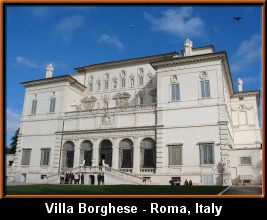 The most interesting parts of the Forum were the columns that seem to sprout up everywhere in the complex.
The Temple of the Vestal Virgins was also very interesting, although there appear to be none left (I know -
bad joke)!
The most interesting parts of the Forum were the columns that seem to sprout up everywhere in the complex.
The Temple of the Vestal Virgins was also very interesting, although there appear to be none left (I know -
bad joke)!
After an all-night flight and a lot of walking in the rain, we decided to head to the Trastevere
for some lunch. We took a right at the Coliseum and headed down to the Circus Maximus, or the Circo Massimo
as the (ancient) locals called it. I was very eager and inevitably a little disappointed to see this. I had a
mental picture of the huge chariot racing facility where Ben Hur defeated the Empire's finest, but all that is
left of this complex is a little grassy park about 500 yards long. There are no remnants of the structure that
used to stand here, although - judging from what we witnessed - it appears to be an excellent place to exercise
your dog. Ah - the decline of Western Civilization. The Circus Maximus is just over Palatine Hill from the
Forum. We continued east of the Circus Maximus, and finally came to the Tiber river. Before crossing over
for lunch in the Travestere, we had a look at
Isola Tiberina, an island in the middle of the river. The island has had a tradition of "healing" since
before ancient Rome. Slaves too tired, old or sick to be of anymore used to retire to this island and pray to
Aesclepius, the greek god of healing.
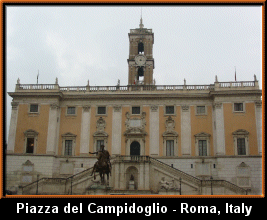 Even today, the island is home to the impressive
Fatebenefratelli Hospital (apparently a fashionable
place for Roman women to give birth today). Also of interest are several bridges that lead on and off the island.
The Ponte Fabricio, or "Bridge of the Four Heads" is one of the oldest
bridges in Rome, dating back to 62 BC. Ruins of several other ancient bridges can be seen from the modern
bridge which leads to the Trastevere on the West bank of the river.
Even today, the island is home to the impressive
Fatebenefratelli Hospital (apparently a fashionable
place for Roman women to give birth today). Also of interest are several bridges that lead on and off the island.
The Ponte Fabricio, or "Bridge of the Four Heads" is one of the oldest
bridges in Rome, dating back to 62 BC. Ruins of several other ancient bridges can be seen from the modern
bridge which leads to the Trastevere on the West bank of the river.
Let's digress a minute here. Rome not only has a reputation for being an ancient city full of history, but
also for being full of individuals who like nothing better than to prey on unsuspecting tourists (kind of like
Disney in the US). After crossing the Tiber, we had one of several such experiences. We were hailed to a car that
had pulled to the side of the road and asked directions to the Vatican. Looking back, this should have been
the first clue: the Vatican is just about the easiest thing to find in Rome (just think - we were tourists and
able to give him directions even though we hadn't been their yet). This fellow then went on to tell us that he
was a sales representative for Christian Dior in Paris and that he was so grateful for our assistance (we basically
told him to turn around - the Vatican is about 1/2 a mile back on the left) that he wanted to give
us a token of his appreciation - a leather jacket, one of his "samples".
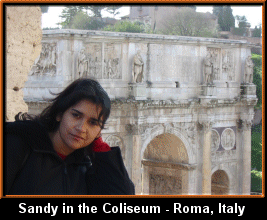 He then proceeded to pull out
a leather jacket that looked as if it had already been through every flea market in Europe since the Middle Ages.
He then launched into a story about how his "French" credit cards didn't seem to be working here in Rome and wondered
if we had any money that we could spare for some gas. Basically, we told him to get lost (ironic, considering that
"being lost" was his ploy from the beginning), threw the jacket back in the window at him, and went
on our merry way.
He then proceeded to pull out
a leather jacket that looked as if it had already been through every flea market in Europe since the Middle Ages.
He then launched into a story about how his "French" credit cards didn't seem to be working here in Rome and wondered
if we had any money that we could spare for some gas. Basically, we told him to get lost (ironic, considering that
"being lost" was his ploy from the beginning), threw the jacket back in the window at him, and went
on our merry way.
This unfortunate experience behind us, we headed into the Trastevere for some lunch. The
Trastevere (literally meaning "across the Tiber") is a classic case of Urban Renewal: It used to be a
poor neighborhood, with large Arab and Jewish populations, but now is the "hip" place to be. It is largely residential
with lots of little alleyways and (as we discovered), great restaurants. This seems to be a good place to comment
on Roman cuisine. Traditionally, in the old days, only the clergy were able to afford meat, so the average Roman
became quite adept at inventing meals out of what was left. One such exaple is the typically Roman dish of
Trippa alla Romana. Basically, if it's made from entrails, Romans probably have a recipe for making it
as appetizing as possible. Citing fragile tummies from the long plane ride, we settled for pizza!
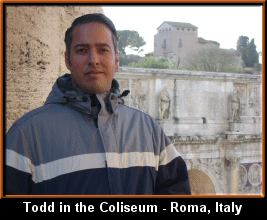 After the all night flight and a full day of sightseeing in the rain, we finally headed to the
Hotel Baltic for a much needed shower and some
rest. I have traveled quite a bit in Europe on business, and have noticed that nowhere else on earth is there
more of a distinction between a 2 star and a 5 star hotel. Our hotel was actually quite nice, and centrally
located, but it suffered from what almost all European hotels suffer: size. Rooms are quite small. The
Baltic had been recently (2001) remodeled though, so it looked quite nice. The hotel is located just a little
north of Termini (90% of all reasonably priced hotels in Rome are within walking distance of the station -
and not nearly as seedy as some guidebooks make them out to be), and was a little hard to find: A door off the
street led into a lobby of a residential building. We had to climb three flights of stairs, or take the elevator
(think small again - separate trips for each of us and the luggage) to register, then we had to go back outside
to another entrance to the stairs that lead to the room. Despite this rather strange arrangement,
the hotel was great.
After the all night flight and a full day of sightseeing in the rain, we finally headed to the
Hotel Baltic for a much needed shower and some
rest. I have traveled quite a bit in Europe on business, and have noticed that nowhere else on earth is there
more of a distinction between a 2 star and a 5 star hotel. Our hotel was actually quite nice, and centrally
located, but it suffered from what almost all European hotels suffer: size. Rooms are quite small. The
Baltic had been recently (2001) remodeled though, so it looked quite nice. The hotel is located just a little
north of Termini (90% of all reasonably priced hotels in Rome are within walking distance of the station -
and not nearly as seedy as some guidebooks make them out to be), and was a little hard to find: A door off the
street led into a lobby of a residential building. We had to climb three flights of stairs, or take the elevator
(think small again - separate trips for each of us and the luggage) to register, then we had to go back outside
to another entrance to the stairs that lead to the room. Despite this rather strange arrangement,
the hotel was great.
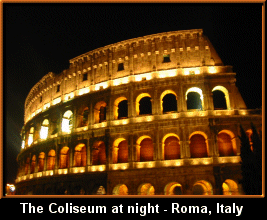 Somehow we found the energy to go out again, and headed north from our hotel to the Scalinata di Spagna
or the "Spanish Steps". My wife lamented that we were not
there to see them in summer when potted Bougainvillea's line the steep steps that lead up to the Church of Santa
Trinita Dei Monti (which I believe means the Church of three Saints on the Mountain - I guess Latin class paid
off just a little bit). Down below, the Piazza di Spagna teams with high end shops and Italians out for a
late night stroll. It seems like all of Rome likes to walk here at night, particularly the younger crowd. I dunno
... call it the "mall" of Italy! :)
Somehow we found the energy to go out again, and headed north from our hotel to the Scalinata di Spagna
or the "Spanish Steps". My wife lamented that we were not
there to see them in summer when potted Bougainvillea's line the steep steps that lead up to the Church of Santa
Trinita Dei Monti (which I believe means the Church of three Saints on the Mountain - I guess Latin class paid
off just a little bit). Down below, the Piazza di Spagna teams with high end shops and Italians out for a
late night stroll. It seems like all of Rome likes to walk here at night, particularly the younger crowd. I dunno
... call it the "mall" of Italy! :)
A rather lengthy walk across Rome and several gelatos later, and we arrived at the Trevi Fountains.
Incredible...you are walking through a rather residential area, and boom - you turn the corner and are confronted by
some of the most amazing sculpture you could possibly imagine. There was quite a crowd here (even in "off season"
November), and we constantly fought off people trying to sell you something or take your picture for money, but it
was worth it to look at the incredible sculpture and fountains. There is quite a police presence here which seems more
content with keeping tourists out of the fountain than with dealing with the miscreants that inhabit the Piazza.
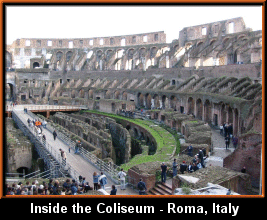 Another day, another round of sightseeing. We decided to visit the Palatine and the Coliseum today, but we
started off by heading north from the Hotel to the Villa Borghese. After getting started with a pastry and a
couple hits of obscenely strong espresso, we continued to the Borghese Gallery. This museum is still undergoing
a renovation, but most of it is still open. Two floors of art await the visitor (be sure to go upstairs even if the
stairs appear to be closed - they aren't), including the absolutely amazing
Apollo and Daphne" , a sculpture by Bernini
depicting Apollo chasing the nymph Daphne who turns into a tree rather than submit to the attentions of Apollo.
I've seen a lot of 2 dimensional art, but this sculpture is amazing: there is literally a different view from every
angle. The detail is just phenomenal. The only disappointing part of this museum is the building itself: from the
outside, it appears to be (and was) a Renaissance style mansion, but the interior walls were rather cheaply done in a
faux effect to emulate marble (strange considering that the cost of Marble in Italy is like the cost of plywood in the
United States). It was just a bit of disappointment that the art was fantastic, but the interior was fake.
Another day, another round of sightseeing. We decided to visit the Palatine and the Coliseum today, but we
started off by heading north from the Hotel to the Villa Borghese. After getting started with a pastry and a
couple hits of obscenely strong espresso, we continued to the Borghese Gallery. This museum is still undergoing
a renovation, but most of it is still open. Two floors of art await the visitor (be sure to go upstairs even if the
stairs appear to be closed - they aren't), including the absolutely amazing
Apollo and Daphne" , a sculpture by Bernini
depicting Apollo chasing the nymph Daphne who turns into a tree rather than submit to the attentions of Apollo.
I've seen a lot of 2 dimensional art, but this sculpture is amazing: there is literally a different view from every
angle. The detail is just phenomenal. The only disappointing part of this museum is the building itself: from the
outside, it appears to be (and was) a Renaissance style mansion, but the interior walls were rather cheaply done in a
faux effect to emulate marble (strange considering that the cost of Marble in Italy is like the cost of plywood in the
United States). It was just a bit of disappointment that the art was fantastic, but the interior was fake.
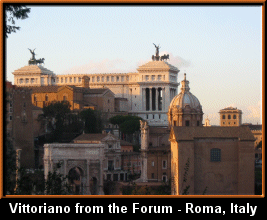 We then made our way to the Coliseum via Rome's underground Metro. This Metro, while a bit more Spartan than
others in Europe, is fast, affordable and convenient. Again, after years of school where the importance of
Rome as the bedrock of western civilization was continually forced down my throat, I was a little disappointed
with the Coliseum: It looked smaller than I expected, no doubt due in part to Hollywood's attempt to portray it
in the film, "Gladiator". Recently on a Discovery Channel special we learned that only about 33 percent of the
original coliseum remains today. None the less,it was still impressive. There is no guided tour (although you can
hire folks outside the entrance who will show you the highlights inside). There wasn't even a proper "guidebook"
for the place (which yet again made it feel more authentic than most tourist traps around the world), but you
could wander around to your heart's content. A recent addition is a pathway across the center of the Coliseum
from which you can look down into the labyrinth that housed the animals, gladiators and other personnel central to
the operation of the games - a real "backstage" view. There are great views from almost every section of the Coliseum. It is more of a ruin than I expected it to
be, and for good reason: Apparently, the stone and mortar blocks used to build the structure were reinforced with
iron bars running throughout the construction. These bars were later "looted" from the Coliseum during the Middle
Ages when armor and weapons were a little more important than preserving a piece of history! You can still see
the holes in the structure where these have been removed.
We then made our way to the Coliseum via Rome's underground Metro. This Metro, while a bit more Spartan than
others in Europe, is fast, affordable and convenient. Again, after years of school where the importance of
Rome as the bedrock of western civilization was continually forced down my throat, I was a little disappointed
with the Coliseum: It looked smaller than I expected, no doubt due in part to Hollywood's attempt to portray it
in the film, "Gladiator". Recently on a Discovery Channel special we learned that only about 33 percent of the
original coliseum remains today. None the less,it was still impressive. There is no guided tour (although you can
hire folks outside the entrance who will show you the highlights inside). There wasn't even a proper "guidebook"
for the place (which yet again made it feel more authentic than most tourist traps around the world), but you
could wander around to your heart's content. A recent addition is a pathway across the center of the Coliseum
from which you can look down into the labyrinth that housed the animals, gladiators and other personnel central to
the operation of the games - a real "backstage" view. There are great views from almost every section of the Coliseum. It is more of a ruin than I expected it to
be, and for good reason: Apparently, the stone and mortar blocks used to build the structure were reinforced with
iron bars running throughout the construction. These bars were later "looted" from the Coliseum during the Middle
Ages when armor and weapons were a little more important than preserving a piece of history! You can still see
the holes in the structure where these have been removed.
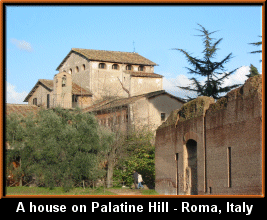 We then headed down the street to the entrance to the Palatine. The Palatine is essentially a giant hill where
the Emperor and many members of the Senate resided. The entire hill is filled with ruins of great houses (some of
them rather surprisingly intact). Because of the height of the hill, you also have fantastic views
of the rest of Rome, including the Vittoriano, the Coliseum, and even St. Peters in the Vatican.
I also had a lot of fun in visualizing the assassination attempt scene from Robert Ludlum's "The Parsifal Mosaic"
which took place on the Palatine and in the Villa Borghese. Books (even fiction) just seem a lot more real
when you have visited the location in which they - real or imagined - took place. The Palatine eventually spit
us back out into the Forum (again, you realize the compactness of ancient Rome) and we strolled through the ruins
literally until security kicked us out at closing time.
We then headed down the street to the entrance to the Palatine. The Palatine is essentially a giant hill where
the Emperor and many members of the Senate resided. The entire hill is filled with ruins of great houses (some of
them rather surprisingly intact). Because of the height of the hill, you also have fantastic views
of the rest of Rome, including the Vittoriano, the Coliseum, and even St. Peters in the Vatican.
I also had a lot of fun in visualizing the assassination attempt scene from Robert Ludlum's "The Parsifal Mosaic"
which took place on the Palatine and in the Villa Borghese. Books (even fiction) just seem a lot more real
when you have visited the location in which they - real or imagined - took place. The Palatine eventually spit
us back out into the Forum (again, you realize the compactness of ancient Rome) and we strolled through the ruins
literally until security kicked us out at closing time.
We then headed to visit some other sites in Rome including the Pantheon. The cool thing about these sites is
that they are not in overly touristy areas: they are in the middle of residential areas. We arrived at the
Pantheon at dusk and went inside where a private church service was in progress, so we didn't get to see much on
the inside, but we did spend some time in the Piazza della
Rotunda. We did a little shopping on some of the side streets and settled down for a great little dinner
here too.
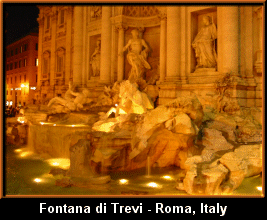 We then headed over to Piazza Navona. This rather unusual Piazza (it's oval shaped rather than
rectangular - it was built on top of a stadium constructed in Ancient Rome) is one of my wife's favorites.
Unfortunately, we discovered that a German company had setup a carnival in the Piazza for the Christmas holidays,
so we had to console ourselves with a few photographs of Bernini's
Fountains of the Four Rivers. We then headed back to the
Coliseum and got some fantastic night photographs of the Coliseum and took a stroll through the Arch of Titus before
heading back to the hotel.
We then headed over to Piazza Navona. This rather unusual Piazza (it's oval shaped rather than
rectangular - it was built on top of a stadium constructed in Ancient Rome) is one of my wife's favorites.
Unfortunately, we discovered that a German company had setup a carnival in the Piazza for the Christmas holidays,
so we had to console ourselves with a few photographs of Bernini's
Fountains of the Four Rivers. We then headed back to the
Coliseum and got some fantastic night photographs of the Coliseum and took a stroll through the Arch of Titus before
heading back to the hotel.
New day - new disaster. We had planned to pack our things, check them at the station and then head over
to the Vatican and St. Peters (it was a Sunday, so we figured we might even catch a glimpse of the Pope holding mass),
but as we packed our things, we realized that something very important was missing: Sandy's wallet. Caesar's
traditional greeting, "Friend, Romans and Countrymen..." should really read, "Theives, Pickpockets and Cutpurses...".
We had been robbed. We figure that it happened between Piazza Navona and the Coliseum the night before.
We were on a crowded bus, and the wallet was in my wife's purse/backpack. One little shove, and...well you can
imagine the rest. Luckily, she had kept her passport separate, but the damage had been done:
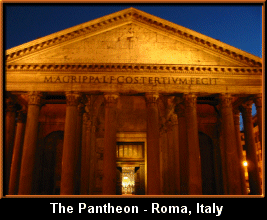 Driver's license,
Venezuelan National Identity Card (not really needed now), and most importantly: her Green Card. Well....the
Vatican was out. We spent the morning at Termini canceling credit cards and trying (in vain) to contact
the American Embassy to find out what we would need for Sandy to get back in the US (more about this at the end of
this tale). Rome began to look quite sinister at that point: people in the train station seemed to be looking at our
luggage with barely disguised longing. We also had a scare when I dropped my Visa Check Card inside a ticket machine
, but luckily with the help of a maintenance person, we were able to retrieve it when he opened the machine. We also
stopped at a local branch of the Carabinieri (the police) to file a report. Sandy, fluent in Italian,
bravely dictated the report to the officer who dutifully hand wrote the report and filed it, after telling us that
the odds of them finding anything were slim and none. On the walk to Termini, we passed another
Carabinieri on the street, who took the opportunity to unsling his Uzi as we walked by - quite a frightening
experience, by the way! We noticed as we proceeded down the street, that we were one block from the Russian Embassy
at the time. I could just imagine how much more scary this incident would have been about 10 years ago during the
cold war!
Driver's license,
Venezuelan National Identity Card (not really needed now), and most importantly: her Green Card. Well....the
Vatican was out. We spent the morning at Termini canceling credit cards and trying (in vain) to contact
the American Embassy to find out what we would need for Sandy to get back in the US (more about this at the end of
this tale). Rome began to look quite sinister at that point: people in the train station seemed to be looking at our
luggage with barely disguised longing. We also had a scare when I dropped my Visa Check Card inside a ticket machine
, but luckily with the help of a maintenance person, we were able to retrieve it when he opened the machine. We also
stopped at a local branch of the Carabinieri (the police) to file a report. Sandy, fluent in Italian,
bravely dictated the report to the officer who dutifully hand wrote the report and filed it, after telling us that
the odds of them finding anything were slim and none. On the walk to Termini, we passed another
Carabinieri on the street, who took the opportunity to unsling his Uzi as we walked by - quite a frightening
experience, by the way! We noticed as we proceeded down the street, that we were one block from the Russian Embassy
at the time. I could just imagine how much more scary this incident would have been about 10 years ago during the
cold war!
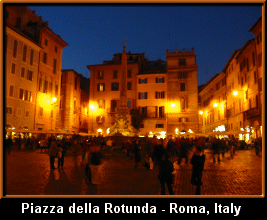 After hours of trying to sort out the purse snatching problem, we finally boarded our train north to Florence.
The train ride from Roma to Firenze
takes about 2 1/2 hours. We had booked first class (definitely a plus - it's worth the extra $15) and enjoyed a
leisurely ride through the countryside on our way North. The outskirts of Rome gave way to lush farmland and we
eventually found ourselves rolling through the fabled vineyards, olive groves and sunflower fields (although it
was winter and they weren't in bloom - in fact, we learned from our friends that the sunflower fields are gradually
disappearing due to a government subsidy that pays the locals NOT to grow them) of Tuscany. We arrived at
Florence's Santa Maria Novella
After hours of trying to sort out the purse snatching problem, we finally boarded our train north to Florence.
The train ride from Roma to Firenze
takes about 2 1/2 hours. We had booked first class (definitely a plus - it's worth the extra $15) and enjoyed a
leisurely ride through the countryside on our way North. The outskirts of Rome gave way to lush farmland and we
eventually found ourselves rolling through the fabled vineyards, olive groves and sunflower fields (although it
was winter and they weren't in bloom - in fact, we learned from our friends that the sunflower fields are gradually
disappearing due to a government subsidy that pays the locals NOT to grow them) of Tuscany. We arrived at
Florence's Santa Maria Novella
We finally made it to Figline, and were picked up by Sandy's friend Delia and her son, Alexander. Delia and Pino
run a small Agritourismo (converted from a 17th century mill) called Molin
del Resco up in the Pratamagno hills between the towns of Regello and Pian di Scò. We headed up into
the hills and finally made it to their house. They have room for about 9 people in their three living areas, the
River Barn, the Granary, and the Stable. We were bunked in the River Barn, and after freshening up, we headed up
to the main house for some dinner and to relax with Delia and her family.
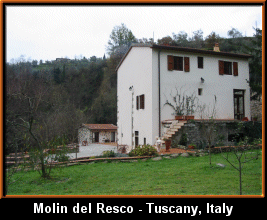 The next day, we decided to relax a little and just hang out and explore the area. We hiked up the hill to the
main road and walked into the town of Pian di Scò. Here we enjoyed espresso and a pastry while looking through
real estate magazines to see if we could afford a place in Tuscany. Ironically, we probably could, as the prices
are about the same as real estate in Northern California. We also spent some time wandering around Pino and Delia's
property which encompasses almost all of a little box canyon immediately below Pian di Scò. They have lots of
olive trees on the property and even press their own olive oil (or trade it to their neighbor for a rather good
Chianti that he produces). We decided to take the train into Florence in the late afternoon. We walked
around a few areas of the city and had dinner at a little pizzeria before heading home early. We were jet-lagged
and spent from all of our experiences in Rome, so this day was pretty much a day of relaxing and hanging out with
Pino and Delia - Sandy used to work for them as an au pair when she lived in Florence and they had a lot of
catching up to do!
The next day, we decided to relax a little and just hang out and explore the area. We hiked up the hill to the
main road and walked into the town of Pian di Scò. Here we enjoyed espresso and a pastry while looking through
real estate magazines to see if we could afford a place in Tuscany. Ironically, we probably could, as the prices
are about the same as real estate in Northern California. We also spent some time wandering around Pino and Delia's
property which encompasses almost all of a little box canyon immediately below Pian di Scò. They have lots of
olive trees on the property and even press their own olive oil (or trade it to their neighbor for a rather good
Chianti that he produces). We decided to take the train into Florence in the late afternoon. We walked
around a few areas of the city and had dinner at a little pizzeria before heading home early. We were jet-lagged
and spent from all of our experiences in Rome, so this day was pretty much a day of relaxing and hanging out with
Pino and Delia - Sandy used to work for them as an au pair when she lived in Florence and they had a lot of
catching up to do!
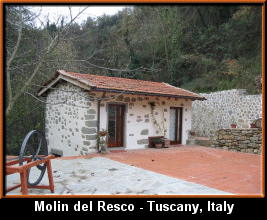 The next day we began our assault on Florence. Delia gave us a ride to the Figline train station while dropping
the kids off at school. We are deeply in debt to Delia and Pino as they gave us a ride to the station almost every
day - the next time we go, we will surely hire a car as it is the only way to explore the countryside. Florence is
a very interesting city in many respects. There are very few, if any modern buildings in the city - it looks (so we
are told) very much the way it did hundreds of years ago. Cars are banned in the center of Florence, except for taxis
and city busses. Even new construction, inevitable in any city, is built to be architecturally compatible with the
existing centuries old buildings. After a quick snack at the SMN train station, we were off. We visited so many
sites in Florence over the 4 days that we were there that it is difficult to remember what we did each day.
The next day we began our assault on Florence. Delia gave us a ride to the Figline train station while dropping
the kids off at school. We are deeply in debt to Delia and Pino as they gave us a ride to the station almost every
day - the next time we go, we will surely hire a car as it is the only way to explore the countryside. Florence is
a very interesting city in many respects. There are very few, if any modern buildings in the city - it looks (so we
are told) very much the way it did hundreds of years ago. Cars are banned in the center of Florence, except for taxis
and city busses. Even new construction, inevitable in any city, is built to be architecturally compatible with the
existing centuries old buildings. After a quick snack at the SMN train station, we were off. We visited so many
sites in Florence over the 4 days that we were there that it is difficult to remember what we did each day.
Acting on a tip from Delia and Pino, we started our first full day in Florence at the Parco delle Cascine
market, which only operates on Tuesdays. I wanted to pick up a few sweaters and maybe a jacket and some shoes (we
made sure that there was plenty of extra room in our suitcases when we started on this trip). The Parco delle
Cascine is laid out in a straight line along the Arno river just a little west of the Santa Maria Novella
, an easy 10 minutes journey by bus.
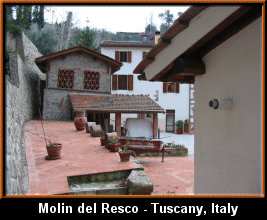 This park is truly multi-purpose: there is a little amusement park (sort of
like a permanent fair) for the kids during the day, and a red-light district for transvestites in the evening hours
(or so we were told - this is definitely not firsthand information)! Reputation notwithstanding, we had a blast
picking our way through the market and looking at clothing, shoes (every possible style you can imagine) jewelry
and leather goods. We finally settled on a just one sweater for me.
This park is truly multi-purpose: there is a little amusement park (sort of
like a permanent fair) for the kids during the day, and a red-light district for transvestites in the evening hours
(or so we were told - this is definitely not firsthand information)! Reputation notwithstanding, we had a blast
picking our way through the market and looking at clothing, shoes (every possible style you can imagine) jewelry
and leather goods. We finally settled on a just one sweater for me.
Because this market was a bit out of the way, we caught the bus again back to SMN, and caught another bus to
Piazzale di Micchelangelo, just below San Mineato al Monte. This piazzale is (during crowded tourist
months) basically a giant parking lot for tour busses, but it does have a few other things to offer, including a
replica of Michaelangelo's David, and incredible views of il Duomo and the Campanile to the northwest,
and San Mineato to the southeast. We snapped quite a few pictures up here, and we wished that we could have
come back here at night for some night shots of the Ponte Vecchio. From the piazzale, it's just a short walk
up a lot of steps to arrive at San Mineato del Monte, one of Florence's oldest churches with an even better
view of Florence than the piazzale. Also here is a centuries old cemetery where some of Florence's most famous
citizens are buried.
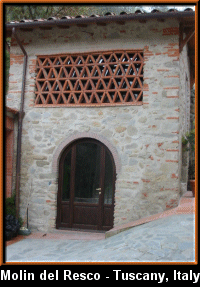 Apparently, due to the limited space available, new plots cost a small fortune, but nonetheless
we did see a few modern grave markers among the old ones.
Apparently, due to the limited space available, new plots cost a small fortune, but nonetheless
we did see a few modern grave markers among the old ones.
We descended from San Mineato by a different route, and found ourselves back down by the Arno river. On the way
down we passed a cat sanctuary. Apparently, there is a huge problem in all of Italy with stray/abandoned cats.
Actually, these cats are a blessing as they help keep down the number of rodents in all of the ruins. We saw
literally hundreds during our walks throughout the Forum and around the Coliseum in Rome. As we walked through
the city, we saw many different styles of a feature of Florence that was to become a fascination for me:
hand-crafted wooden doors. So many different styles, all with doorknobs in the center of the door instead
of off to one side as most are in the United States. Each door was apparently hand crafted. Simply amazing!
We crossed the Arno again, heading back towards the train station and stopped for a while in the
Piazza Della Signoria. If there is a "center" to Florence, this would be it (or the Piazza
Repubblica). Everything is here: The Palazzo Vecchio, the Uffizi and the Loggia dei
Lanzi. The Loggia dei Lanzi if probably the best place in Florence to see some world-class sculpture
for free: There are several sculptures in this alcove that used to be in the Uffizi, but were moved
outside for the public to enjoy. Also present in the plaza is a sculpture of Neptune or Il Biancone
by Ammannato, which tourists seem to enjoy but is Scorned by
locals. The most interesting site is the plaque embedded into the surface of the piazza honoring the death
of Girolamo Savonarola, who in his divine wisdom tried to bring Renaissance Florence back under religious authority
by staging the infamous "Bonfire of the Vanities" in which he burned many priceless artworks. He was on the
receiving end several years later when the Florentines returned the favor and burnt him to death in the same
spot.
For dinner we selected a restaurant near the Piazza San Lorenzo. Dinner was fabulous as we expected.
I've come to enjoy Northern Italian cuisine with its cream based sauces, meat and cheese over Southern Italian
food which has more of a tomato base. We had a really interesting experience happen on the street outside our
restaurant. While we were shopping at the Parco delle Cascine, we noticed quite a few African gentlemen
who would carry around large bundles wrapped in a sheet. In the middle of the market, they would 'unpack' the
blanket to reveal black market (pirated) compact discs and DVDs. Of course, this is illegal, and the reason for
the blanket is so they can grab all four corners and quickly 'wrap things up' if law enforcement happens upon them.
Just such an incident occurred outside of the restaurant. We heard cries of 'Carabinieri...Carabinieri! and
then saw half a dozen men run past the window clutching sheets full of merchandise. This one turned out to be a
false alarm, and the men then proceeded to unwrap their merchandise right in front of the restaurant. It turns out
that these guys do quite a brisk business because - as we discovered the next day - prices for CDs in shops in
Florence are astronomical! They wanted €24 for a CD that we later bought from CDNOW online in the US for $15. It's
almost worth ordering it online and paying for shipping from the US to Italy.
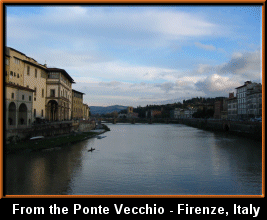 After dinner we explored the San Lorenzo Market. This is the place to come if you want leather articles:
wallets, jackets, book covers, jackets, hand bags...you name it and it's here in this sprawling market that seems
to stretch out in all directions. After dodging my wife's ex-boyfriend (from when she lived in Florence), we
made a few other purchases. We bought several scarves for friends and seriously considered a couple of modern
tapestries for our home. We searched also (to no avail) for a marble chess set to take home as a souvenir.
The folks who tend these markets seem to be able to smell a tourist a mile away. They were a bit pesky (pesky
for Europe, but not nearly as annoying as South Americans) with their sales pitch, so we switched to Spanish to
discuss what we liked and disliked (I know enough to do this), but wouldn't you know it - some of those folks
spoke Spanish too. Oh well - it was worth a try.
After dinner we explored the San Lorenzo Market. This is the place to come if you want leather articles:
wallets, jackets, book covers, jackets, hand bags...you name it and it's here in this sprawling market that seems
to stretch out in all directions. After dodging my wife's ex-boyfriend (from when she lived in Florence), we
made a few other purchases. We bought several scarves for friends and seriously considered a couple of modern
tapestries for our home. We searched also (to no avail) for a marble chess set to take home as a souvenir.
The folks who tend these markets seem to be able to smell a tourist a mile away. They were a bit pesky (pesky
for Europe, but not nearly as annoying as South Americans) with their sales pitch, so we switched to Spanish to
discuss what we liked and disliked (I know enough to do this), but wouldn't you know it - some of those folks
spoke Spanish too. Oh well - it was worth a try.
When we arrived back at Figline, we decided to take a bus up to Pian di Scò, and call our friends to come
and pick us up from there instead of driving all the way down hill to Figline. This was a cool ride and we
got to drive through some of the other towns in the area. When we arrived at Pian di Scò, we realized that there
was a full moon, so we decided to walk the mile to Delia and Pino's place.
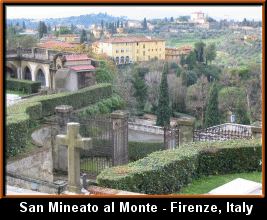 This was a really neat experience:
totally quiet and dark, we made our way down their lane (which has no lights). They were really surprised to see
us turn up at their gate and buzz them to let us in!
This was a really neat experience:
totally quiet and dark, we made our way down their lane (which has no lights). They were really surprised to see
us turn up at their gate and buzz them to let us in!
The following day we decided to visit the Uffizi Gallery. Pino works part-time at the Uffizi
and was able to get us smuggled in...very cool! Apparently, in the peak tourist seasons, there are long queues
to get into this place, leading some folks to even pre-purchase tickets to get in. Fortunately, in late November,
tourists are few and far between, and we were able to get right in. The Uffizi occupies the upper and lower
floors around the Piazza Della Signoria, and is absolutely (for lack of a better word) huge.
The gallery is "U" shaped, with galleries accessible from the corridor on the inside of the "U". There are
thousands of portraits in the corridor in addition to those in the galleries. This place is actually quite
overwhelming and takes hours to view even small sections. There is even a nice little cafe in the Uffizi
overlooking the Piazza Della Signoria.
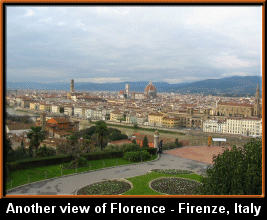 Another must see was Michealangelo's David. This sculpture is located in the Galleria dell'Accademia.
This is another place infamous for its long queues, but once again visiting during the off season was a blessing -
we got right in. There are plenty of other things to see here: They have a lot of sculpture casts - the concrete
models built first before the artist starts carving marble - from many famous sculptures and they had a temporary
exhibit on musical instruments (which I found delightful). But the true reason that everyone visits the gallery
is David, or simply 'Dave' as I call him. There are sculptures, and then there are sculptures. I must say that
one can immediately see the superiority of this sculpture over all other sculptures. First off, this thing is
huge. I would estimate that the statue stands about 15 feet tall. The interesting thing is that the proportions of
the parts of the body are amazingly accurate: It looks so real that you almost expect it to be able to step right
off the platform. The only disappointing part is that 'Dave' is currently undergoing some enhancement (if it's
plastic surgery for humans, I guess that one could call it 'stone surgery' for sculpture), and thus he is surrounded
by a low wall and people are constantly 'working' on him.
Another must see was Michealangelo's David. This sculpture is located in the Galleria dell'Accademia.
This is another place infamous for its long queues, but once again visiting during the off season was a blessing -
we got right in. There are plenty of other things to see here: They have a lot of sculpture casts - the concrete
models built first before the artist starts carving marble - from many famous sculptures and they had a temporary
exhibit on musical instruments (which I found delightful). But the true reason that everyone visits the gallery
is David, or simply 'Dave' as I call him. There are sculptures, and then there are sculptures. I must say that
one can immediately see the superiority of this sculpture over all other sculptures. First off, this thing is
huge. I would estimate that the statue stands about 15 feet tall. The interesting thing is that the proportions of
the parts of the body are amazingly accurate: It looks so real that you almost expect it to be able to step right
off the platform. The only disappointing part is that 'Dave' is currently undergoing some enhancement (if it's
plastic surgery for humans, I guess that one could call it 'stone surgery' for sculpture), and thus he is surrounded
by a low wall and people are constantly 'working' on him.
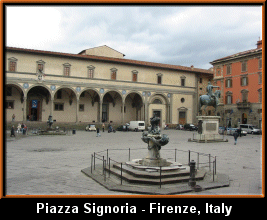 Originally, we had planned to visit Venice for two days on this trip, but the fact that Venice was sitting
under about 6 feet of water (compliments of some recent devastating storms) put a damper (no pun intended) on
this plan, so instead, we soaked up a bit of the Tuscan countryside. We visited nearby Regello where Sandy had
lived for a while. This is a great little town up in the hills with picturesque streets and fabulous views. It's
amazing how relaxing (this was somewhat offset by continuing attempts to contact the American Consulate in
Milan) walking around a small town like this can be. We had dinner at a great little restaurant
(and it seems like they are all "great little restaurants" in this part of Italy) where Sandy had often eaten
when she lived in Regello and she was able to eat one of her favorite items: Pizza with Arugula and Cream: It
sounds weird (and looks weird too), but I tried it and it was pretty good. We also spent an evening with Pino and
Delia enjoying an 'Olive Festival' in Regello. Here we were able to taste not only great wine and vin santo, but
also differnt locally grown and pressed olive oil under a tent in the middle of Regello.
Originally, we had planned to visit Venice for two days on this trip, but the fact that Venice was sitting
under about 6 feet of water (compliments of some recent devastating storms) put a damper (no pun intended) on
this plan, so instead, we soaked up a bit of the Tuscan countryside. We visited nearby Regello where Sandy had
lived for a while. This is a great little town up in the hills with picturesque streets and fabulous views. It's
amazing how relaxing (this was somewhat offset by continuing attempts to contact the American Consulate in
Milan) walking around a small town like this can be. We had dinner at a great little restaurant
(and it seems like they are all "great little restaurants" in this part of Italy) where Sandy had often eaten
when she lived in Regello and she was able to eat one of her favorite items: Pizza with Arugula and Cream: It
sounds weird (and looks weird too), but I tried it and it was pretty good. We also spent an evening with Pino and
Delia enjoying an 'Olive Festival' in Regello. Here we were able to taste not only great wine and vin santo, but
also differnt locally grown and pressed olive oil under a tent in the middle of Regello.
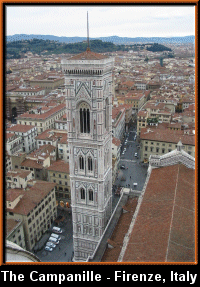 The time had finally come to bid Italy farewell. And about time too: I was too full. My belly was full of fine
Italian cuisine and my head full of ideas (courtesey of Rome and Florence) for remaking our home and garden back in
California. We were eager and sad at the same time. Pino drove us South to Arezzo to catch a train - we had to
leave early and there were no trains available from Figline to Florence early enough to get us to Rome in time to
catch our flight. Armed with our souvenirs - mainly a few items of clothing and some bottles of wine, vin santo and
olive oil, we headed back to the United States.
The time had finally come to bid Italy farewell. And about time too: I was too full. My belly was full of fine
Italian cuisine and my head full of ideas (courtesey of Rome and Florence) for remaking our home and garden back in
California. We were eager and sad at the same time. Pino drove us South to Arezzo to catch a train - we had to
leave early and there were no trains available from Figline to Florence early enough to get us to Rome in time to
catch our flight. Armed with our souvenirs - mainly a few items of clothing and some bottles of wine, vin santo and
olive oil, we headed back to the United States.
We arrived in Atlanta where we had a 3 hour layover before our next flight leg to Sacramento. A good thing, this
three hour layover, as we were about to experience the full force (and inefficiency) of the Federal Government of the
United States of America in full effect. Of course, in Immigration, we were stopped because of the theft of Sandy's
'green card'. Normally, this would not be a problem: When given temporary permanent residence status (there's an
oxymoron in there somewhere - temporary permanent?), Sandy had an I-95 'stamp' put in her passport. This stamp allowed
her to travel outside the country on her Venezuelan passport and still be allowed back into the US. Unfortunately,
her passport was due to expire in Feburary (2 months after our return). Many countries require at least 6 months
validity on a passport to enter their country. Since this was the case in this instance, several months before our
trip, Sandy had her passport renewed at the Venezuelan Consulate in San Francisco. They, of course, re-issued a new
passport and 'invalidated' the old one. So, what this meant for us was that the passport that she had to use to
re-enter the United States was the new one that did not have the I-95 stamp in it. She was carring her old 'invalidated'
passport also, which had her alien number on it (so they could look it up).
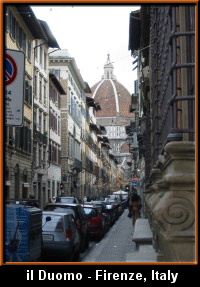 The conversation with the INS folks in Atlanta went something like this (after 30 minutes of waiting):
The conversation with the INS folks in Atlanta went something like this (after 30 minutes of waiting):
Them: "So...you've lost your green card, eh?"
Us: "No, we didn't lose it...it was stolen. Here's a copy of the police report from Rome."
Them: "Whatever - do you have $130"
Us: "Do you take Visa or a check"
Them: "No" (followed by complete silence from them).
At this point, I eventually arranged for them to escort me out of the immigration area (they needeed to be sure that
I returned, as I had yet to pass through Customs) to an ATM in the airport to withdraw the money. After seeing that
we had the ability to pay for a new green card, their attitude changed completely and they were much nicer, inquiring
about our trip, etc. Creeps. Oh well, at least we were able to get this taken care of here instead of facing the
bureaucracy in Sacramento. $130 bought us the coveted I-95 stamp in Sandy's new passport and the promises that the
process of getting a new green card were underway.
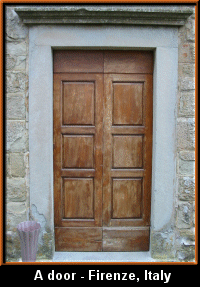 Apparently, this is a really big business: Immigrants 'lose' their Green Card (which can be sold, apparently,
for thousands of dollars on the black market) all the time. We were told in Atlanta that Sandy's new green card should
arrive in approximately 4 to 6 weeks. As of May 2002 (six months later) we still do not have the replacement green
card. When we called the California INS office, they said that they had absolutely no record of an application for a
new card. We were dumbfounded. We gave them the receipt number of the receipt we were given in Atlanta and they 'could
not find it'. Several calls later (it seems like you get a different answer every time you call the INS), we were
told, "..oh....that makes sense. If you reported it stolen in Atlanta and filled out the paperwork there, your
application was sent to the Dallas regional office. This adds about 6 months to the process, since your replacement
card will have to be issued by the regional office where you reside...". So much for efficiency. Given that the INS
is now in transition to the department of Homeland Security, it will probably take another 6 months before we receive
the card.
Apparently, this is a really big business: Immigrants 'lose' their Green Card (which can be sold, apparently,
for thousands of dollars on the black market) all the time. We were told in Atlanta that Sandy's new green card should
arrive in approximately 4 to 6 weeks. As of May 2002 (six months later) we still do not have the replacement green
card. When we called the California INS office, they said that they had absolutely no record of an application for a
new card. We were dumbfounded. We gave them the receipt number of the receipt we were given in Atlanta and they 'could
not find it'. Several calls later (it seems like you get a different answer every time you call the INS), we were
told, "..oh....that makes sense. If you reported it stolen in Atlanta and filled out the paperwork there, your
application was sent to the Dallas regional office. This adds about 6 months to the process, since your replacement
card will have to be issued by the regional office where you reside...". So much for efficiency. Given that the INS
is now in transition to the department of Homeland Security, it will probably take another 6 months before we receive
the card.
But we digress: Italy was lovely and we are planning to go back this year in combination with a trip to
Prague. I've got nothing but wonderful things to say about visiting Italy in the off season. You're not really
missing much except for hot, dusty conditions and huge mosquitos and crowds in Florence, or so I am told. I'd really
like to go back earlier in the fall so that we can catch the grape harvest: Unlike the wineries here in California
(who remain open for tasting all year long), most wineries were closed so we missed out on the opportunity to taste
some Chianti. Of course, there are many things for us to still see in Italy:
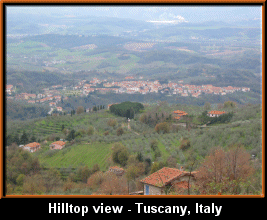 We'd like to visit the coast, particularly around Cinque Terra and San Remo, and visit some southern Italian cities
as well. We still need to get to Venice sometime when it's not underwater or totally mobbed by tourists (which
REALLY limits our options). We have grandiose plans for a kayak trip in Sardinia at some time in the future too.
We'd like to visit the coast, particularly around Cinque Terra and San Remo, and visit some southern Italian cities
as well. We still need to get to Venice sometime when it's not underwater or totally mobbed by tourists (which
REALLY limits our options). We have grandiose plans for a kayak trip in Sardinia at some time in the future too.
Of course, the 'really big plan' is to buy a Tuscan farmhouse or 'Colonica' and retire in Italy. Why not?
I can't think of a better place to live (of course, this means living without some of the bare necessities such as
DSL :) Beautiful countryside, a laid back lifestyle and nothing to do buy enjoy life. Sandy has been trying to
convince me of how Italy is a great place to live since we first met. I am convinced, even if my own preference has slide to second place on the list. Of course, there
would be a downside to moving to Italy: I wonder if Sandy could handle the additional 25 lbs that I would gain eating
all that incredible Northern Italian cuisine? If I have to live without DSL, she can live with me being large!
Sandy and I would both like to thank Pino and Delia at Molin del Resco for
the accomodation. We can both highly recommend their agritourismo, and not just because they are friends. We are
still tring to get our families together for a week at their place!
Other Destinations
 Big
Sur, California Big
Sur, California |
 Lisbon,
Portugal Lisbon,
Portugal |
 Paris,
France Paris,
France |
 Madrid,
Spain Madrid,
Spain |
 São
Paulo, Brazil São
Paulo, Brazil |
 Caracas,
Venezuela Caracas,
Venezuela |
 Amsterdam,
Netherlands Amsterdam,
Netherlands |
 Arnhem,
Netherlands Arnhem,
Netherlands |
 Nassau,
Bahamas Nassau,
Bahamas |
 London,
England London,
England |
 Curaçao,
Netherland Antilles Curaçao,
Netherland Antilles |
 Santiago,
Chile Santiago,
Chile |
 Edinburgh,
Scotland Edinburgh,
Scotland |
 Vancouver,
British Columbia, Canada Vancouver,
British Columbia, Canada |
 Hyderabad,
India Hyderabad,
India |
 Rome
& Florence, Italy Rome
& Florence, Italy |
|
|
© 2003 - Todd L. Holsopple
All photographs and HTML content are protected by copyright and may not
be used without written permission from Todd L Holsopple. Please
feel free to link to these pages without permission.
|
Web site hosted by http://www.ipowerweb.com
 I've always wanted to go to Italy ever since Latin class in High School (most if not all of which
I have forgotten over the years) where we not only learned the language, but also the culture of the
ancient Romans. The Forum, the Coliseum, the Palatine...the birthplace (along with Greece) of
western civilization: I wanted to see it all. Unlike some other foreign adventures, I also had a
secret weapon: A wife who had lived in Florence and who speaks fluent Italian! This was going to
be great.
I've always wanted to go to Italy ever since Latin class in High School (most if not all of which
I have forgotten over the years) where we not only learned the language, but also the culture of the
ancient Romans. The Forum, the Coliseum, the Palatine...the birthplace (along with Greece) of
western civilization: I wanted to see it all. Unlike some other foreign adventures, I also had a
secret weapon: A wife who had lived in Florence and who speaks fluent Italian! This was going to
be great.






































